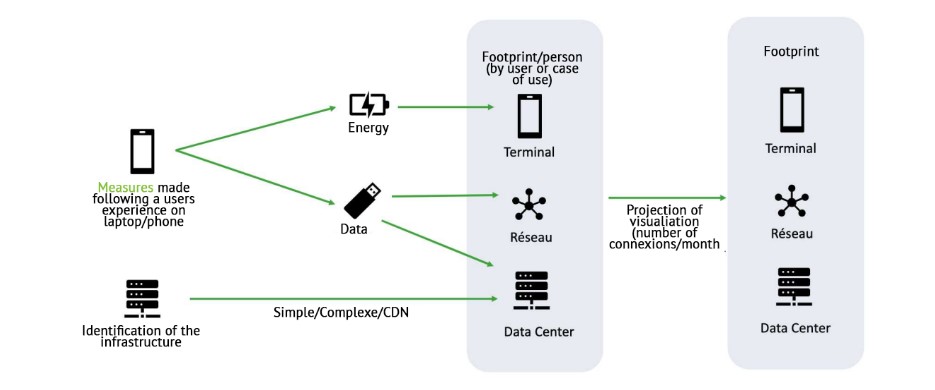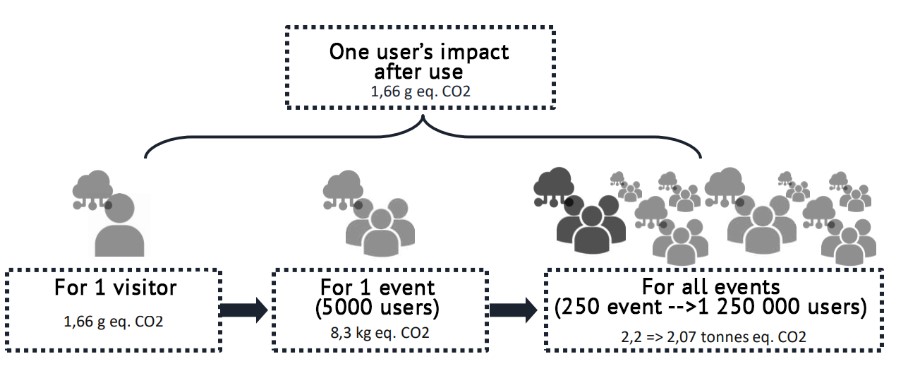The future of the event industry & the rise in climate change
The events sector is one of the human activities with a high carbon impact, moving hundreds of participants and generating a lot of waste in short amounts of time. What is the value of virtual events in terms of helping out our environment?
After successive IPCC reports, and a devastating 2022 summer: it is only clearer that the climate emergency is real and that it is essential for everyone to act on a daily basis.
With 32 billion euros in economic spin-offs, the events sector is not one the most polluting industries (1). However, its impact is real, measurable and moving towards a responsible approach respecting the planet must now be at the heart of our concerns.
When we say events: what are we talking about?
When we talk about the event industry, we often think of fairs, trade shows, exhibitions, either intended for the general public, professionals, or private employees.
These in-person events often also include many advertising objects, packaging, and tons of flyers. If we also take into account attendees’ travels, logistics, electricity consumption, booth set ups, hospitality and food waste: this only confirms it has a real impact on our planet. The majority of the booths and extras are not reused and increase the carbon footprint of in-person events.
The ADEME highlights (2) that an average event of 5,000 attendees would generate 2.5 tons of waste and consume 1,000 kWh of energy and as much as 500 kg of paper.
Thankfully the events sector has already taken action to reduce its impact on the planet.
There are many solutions put in place by event organizers: the use of recycled or recyclable materials is widespread, reusable booths can be designed; some are even reducing their waste by using cardboard or recycled tableware, etc.
The most committed propose vegetarian or local food, in order to reduce the carbon impact of meals and try to balance out the negative impact.
However, these solutions do not reduce travel or the impact of the logistics, which continue to influence carbon emissions greatly.
Going online: the best solution?
For the majority of events, virtual platforms have already proven its worth in terms of attractiveness, accessibility, and engagement. The recent health crisis has accelerated the development of this type of solution, and today everyone knows how to use a chat or a video tool, whether it is for working from home or a remote event.
Of course, some events cannot be done online: food cannot be tasted in the Metaverse (do we really want to…?), and local gastronomy fairs will only ever take place in person, and that’s all the better for our taste buds…
On the other hand, let’s seriously ask ourselves one question: does an international business fair, a meeting with suppliers, or a university’s open day, require hundreds of people to travel thousands of kilometers to exchange business cards, sign a contract, or submit an application?
As a responsible organizer, it now seems essential to take this into account before launching an event: what option can be offered to visitors and exhibitors who want to reduce their carbon footprint? Can virtual events not share effectively videos, documents, images, links, and organize conferences or allow discussions through chat and video calls?
It’s a fact: virtual events can considerably reduce the carbon emissions of an event. If we want to take a real example, the Climate Summit did the comparison (3) and the numbers speak for themselves: 3 kg of CO2/attendee for a virtual version, against 48 kg for the same summit carried out physically. South Pole did a similar study (4) in 2021 for PRODURABLE. This study highlights several interesting elements, such as the fact that the traveling of participants accounts for 49% of the total impact in face-to-face events.
Even if these figures concern a specific event, we can easily transpose them to all kinds of events: the best way to avoid producing CO2 will always be to stay at home.
So to be completely transparent on the subject, we ourselves have done the exercise of measuring the carbon impact of an event held on AppyFair by an independent external organization: you will see at the end of the article that the values measured are undeniably reassuring!
What about digital pollution?
Technologies too are the source of many carbon emissions and have a considerable environmental impact. In 2017, Greenpeace published a report (Clicking Clean), estimating the share of energy consumption of the global Internet at 7% of all electricity consumed worldwide. With the recent reports on the pollution generated by the Metaverse, we have the right to ask ourselves if digital technology is a solution that makes sense in the long run.
Here again, everyone can act with simple tricks to reduce their digital impact, and we’re not just talking about turning off the Wi-Fi! We are preparing an article on this subject that we will share with you soon.
What is digital sobriety?
Digital Sobriety aims at reducing as much as possible the environmental impact linked to a technology by using less energy greedy solutions and by communicating on good practices. With AppyFair, digital sobriety is extremely important to us and we are doing our best to make virtual events a trusted and eco-friendly solution.
How to define a digital sobriety index?
We can define this index by measuring the environmental footprint of our technology. Of course, we can’t control everyone’s personal choices (delete emails, use green energy, switch off computers when away, etc.). However, we can make sure that our platform requires as little resources as possible. To measure this index and be as objective as possible, we have called upon an external organization: Greenspector.
Greenspector is a company that specializes in measuring and analyzing the Carbon footprint of digital technology. They have developed their own tools to measure, analyze and improve the energy and resource consumption of mobile and web applications. Thanks to their advice and expertise, and in partnership with ADEME, we are proud to announce that we were able to obtain the “Bronze level” of their Digital Sobriety Certificate.
How did we get our Digital Sobriety Certificate?
The methodology used by Greenspector is conducted through a resource consumption measurement campaign as follows:
- Automated tests were used to follow the user’s experience on our platform
- During the user’s journey, the application’s consumptions were measured
- An evaluation of the carbon impact linked to the use of the application was made
- The results where then analyzed by Greenspector experts
- Improvements KPIs are provided by these experts to the technical team
- The code is reviewed by the AppyFair development team, in order to get as close as possible to the recommendations provided
- A second analysis measures the real impact of these optimizations
The measurements were performed on real devices, including a Samsung Galaxy S7. Each measurement was repeated 3 times to guarantee a better results reliability. The metrics measured are the following:
- Performance (loading time expressed in seconds)
- Energy consumption (represented by the discharge rate of the battery in µAh/s)
- Data exchanged on the network (in KB)
The measurements steps take into account the whole ecosystem related to the platform:

The tests revealed that the impact of the experience for one attendee on AppyFair represents 1.66 g eq. CO2.

In 2020, with more than 250 virtual fairs organized and more than a million of visitors gathered on our platform, we generated, according to this study, the CO2 emissions equivalent to the use of a single car during a year (5 ).
Our successive optimizations have enabled us to obtain the “bronze” level of the digital sobriety label, which is an excellent result considering the level of interactivity and engagement that we offer. Thanks to the advice of Greenspector’s experts, we have already taken action, and we plan to reach the demanding Silver soon.
This certificate confirms our desire to be ever more responsible and to offer event organizers solutions for more carbon-neutral events.
Come and participate with us in the effort to build the virtual events of tomorrow!
References : see the french version of the article
Some more news?
Don’t hesitate to go through our articles and detailed guides!
The future of the event industry & the rise in climate change
The events sector is one of the human activities with a high carbon impact. What is the value of virtual events in terms of helping out our environment?
Using virtual events for recruitment & employer branding
Virtual events can be a great tool to strengthen your employment brand for recruitment. Internal mobility, progression, training, career management, recruitment...
Virtual events for education: the latest must-have technology!
From a very young age, school is a key part of our lives. The education sector regroups various organizations (engineering schools, business schools, universities...) that all share a common goal: to offer as many students as possible the opportunity to find their way, and above all to get the job of their dreams!


